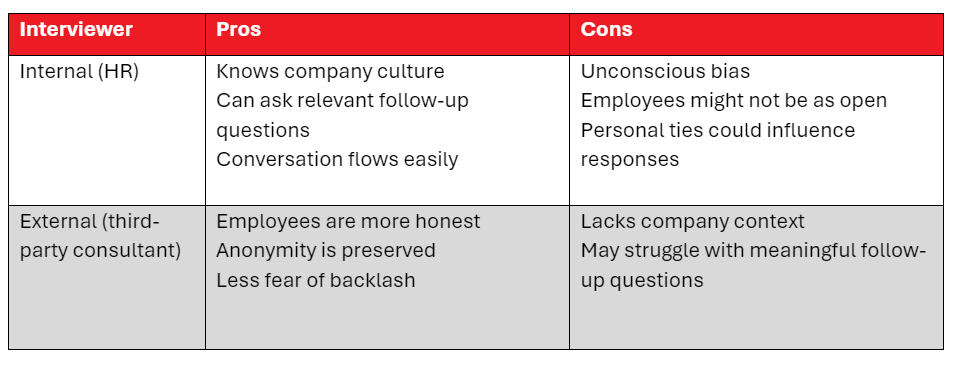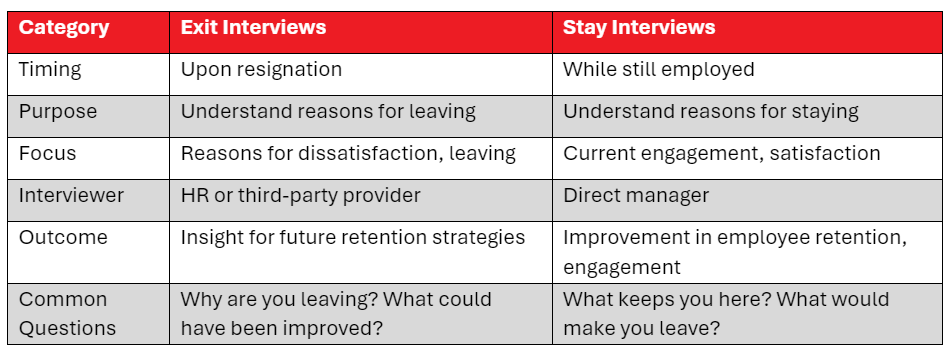
Exit interviews reveal why employees leave. How can these interviews improve retention and enhance workplace culture? Find out more in this article

Exit interviews are part of an employee lifecycle, a bookend of sorts to the onboarding process. Sadly, some companies treat these final interviews as an afterthought or a box-ticking exercise. If done right, these offboarding interviews can offer invaluable feedback for the organisation. Strange as it sounds, exit interviews can even serve as effective retention tools!
In this article, we’ll take a closer look at the exit interview: what is it for? What are some key questions to ask? Are exit interviews mandatory in Australia?
More importantly, we’ll look at how exit interviews can help improve workplace culture. We’ll also examine your role in this process, and how you can bring about change in your organisation.
An exit interview is a structured conversation between a departing employee and a representative of the organisation.
The main purpose of an exit interview is to gather feedback from the departing employee. Data gathered is used to analyse areas for improvement within the organisation, especially if several employees point to a common reason for leaving.
An HR practitioner or an external consultant can lead the exit interview; each one offers distinct advantages.
As an HR practitioner, you have the clear advantage of knowing the company culture. You can ask open-ended and follow up questions in a way that makes sense. The conversation tends to flow more easily with someone like you who is familiar with the context that the employee talks about.
On the flip side, you might bring some unconscious bias to the interview. The employee might not be as open with their answers. If you have ties to certain personalities within the company, that might be another reason for the employee to hold back.
Results from interviews done with third-party consultants tend to be more accurate. Departing employees tend to be more honest and forthcoming with someone from outside the organisation. There’s no fear of backlash because anonymity is preserved.
Here’s the drawback: external providers lack the context that allows them to ask meaningful follow-up questions.
Regardless of whether the exit interview is done internally or externally, the departing employee’s manager should never be part of the exit interview. This allows the employee to be more open and candid with their answers.
Here’s a summary of pros and cons for an internal vs external interviewer:

Exit interviews are not compulsory in Australia. Departing employees, however, are encouraged to participate to share their views on a range of issues such as:
Allowing people to leave without an exit interview is a missed opportunity for the organisation. The insights and first-hand experience of a departing employee offer valuable feedback. Leaders and managers learn more about what the organisation does well and what it can do better.
Exit interviews are an integral part of a company’s retention strategy. Here’s one way to quantify its importance:
Based on the Australian HR Institute’s last retention report, 83% of companies used exit interviews as their source for employee retention data.
The same report also showed that 63% of employers do not measure the cost of turnover. Here’s the latest on that: as of June 2024, the cost of turnover of one employee is $20,265.
Exit interviews can reduce turnover costs by acting on a departing employee’s feedback. The concerns the employee raised might be the same issues the rest of the workforce is facing.
These final feedback interviews can also help shape organisational culture and policies. Honest and candid answers from a departing employee offer valuable insights into areas for improvement.
Lastly, an exit interview – if handled well – can help the employee end their tenure on a positive note. Giving the employee the chance to talk about their concerns helps build goodwill between the leaver and employer.
Whether an exit interview is good or bad depends on a few factors:
In theory, an exit interview is good practice. It’s an opportunity for an organisation to get feedback on its company culture, HR processes, management, and leadership structure.
Some HR practitioners find stay interviews as a more proactive approach to employee retention. Unlike exit interviews, stay interviews are done while the employee is in the role. They serve as quick check-ins to see what makes an employee stay or what would make them leave.
Another important distinction: a stay interview is done by the manager, not HR or a neutral third party. It's not part of any formal process.
Stay interviews work best in a workplace that encourages open, honest communication. Employees should feel that they can share their thoughts without fear of backlash or punishment.
Here’s how exit interviews and stay interviews compare:

Find out how organisations can benefit from stay interviews in this article.
Asking the right questions can make or break an exit interview. Some areas to cover:
Here are a few sample questions to ask under each topic. Our article on exit interview questions to ask has a more complete list.
The most important and obvious question here is: why is the employee leaving? Asking questions about their experience helps uncover valuable insights into workplace culture, leadership effectiveness, and potential areas for improvement.
These are important questions to ask. Exit interviews often touch on sensitive topics, especially feedback about managers. Asking the right questions can highlight issues like ineffective leadership or poorly designed roles.
As companies focus on diversity and inclusion, exit interviews can offer insights into workplace culture and support gaps. These interviews help identify areas where the organisation can improve, such as compensation, support, and overall culture.
Employee engagement is a solid strategy for keeping your team happy. Watch our interview with Louise Hope, one of the best HR executives in Australia, as she talks about what her company’s engagement strategy involves:
Read this opinion piece on employee engagement strategies for more ideas!
To make sure that the objectives and intentions of an exit interview are met, following best practices is key. Exit interviews offer valuable insight and feedback on a departing employee’s experience with the company. It’s important to take an intentional approach and offboard employees gracefully.
Here are some best practices for conducting exit interviews:
Every company should have a formal exit policy in place covering these points:
The policy should cover a plan for collecting and analysing information from the exit interview. It should also include a section on privacy and data protection to avoid any breach of confidentiality.
Exit or offboarding interviews can be done any time after an employee turns in their notice and before their last day. In some cases, exit interviews are done after employees have left the company.
Some experts suggest doing the exit interview towards the middle of an employee’s notice period. There are some advantages to choosing this time frame:

The ideal length for exit interviews is 60 to 90 minutes. This gives you some leeway to ask open-ended questions to build rapport and get to the root of the issue. The employee can also answer questions without feeling constrained or rushed.
Set aside enough time, energy, and effort to get ready for an exit interview. What does that mean?
Review your company’s policy on exit interviews to help you address any questions or issues during the interview itself.
On the day of the interview, make sure the meeting room is comfortable and offers some privacy.
Be at the meeting room early to do a final check of the space. When your colleague arrives, welcome them and thank them for agreeing to speak with you. (Exit interviews aren’t mandatory after all, so they are doing the organisation a favour by sharing their views with you.)
Before you begin, go over these points:
Explain the objectives of the exit interview. Give an overview of the guidelines and why they’re an important part of the company’s HR policies.
Outline the confidentiality rules. Assure your colleague that what they say will be kept private. This should encourage open and honest responses.
Tell them what happens with the information they share. Explain how the data will be collected, stored and used.
Go over the standard exit interview questions. You’ll need to do a fine balancing act here: stick to the questions yet be attuned to opportunities for open-ended queries. Give your colleague the chance to explain further if needed.
Practice active listening; pick up on answers that require a bit more clarity or context. Pay attention to facial expressions and body language. See where a bit of probing might be required.
There might be a tendency to ask leading questions. Be aware of your own biases and perceptions; try to be as objective as possible.
Capture the data as soon as possible while the details are still fresh in your mind. Enter the findings in your company’s database or HR information system. Choose from among the best HR analytics tools to help with this task.
Analyse the data and identify trends. Look at recurring issues, spot for one-offs, and look closely at repetitive concerns.
Compare exit interview data against other employee surveys. This should give you a bigger picture of the organisation’s strengths and weaknesses.
The most important task after the interview is creating an action plan based on the information gathered. Get management, team leads, and the rest of HR involved. Set goals and deadlines to make each one accountable. The goal is to improve systems or processes and address any issues in the organisation.
Insights gathered from the departing employee should lead to positive change within the company.
Losing a valued employee and having high turnover rates are never good news. There is a silver lining though: with exit interviews, HR managers can learn about the company from the departing employee’s point of view. These insights can help uncover blind spots, leading to improvements in leadership, processes, and culture within the organisation.
Exit interviews are a valuable feedback tool for organisations, but they have to be done right. Have a robust policy in place. Set up HR systems that help analyse data gathered. Invest in solid retention programs for your workforce. Above all, build a culture of openness and transparency. Make your employees want to stay to make exit interviews a thing of the past.
Are you ready to rethink your exit interview process? Let us know in the comments below